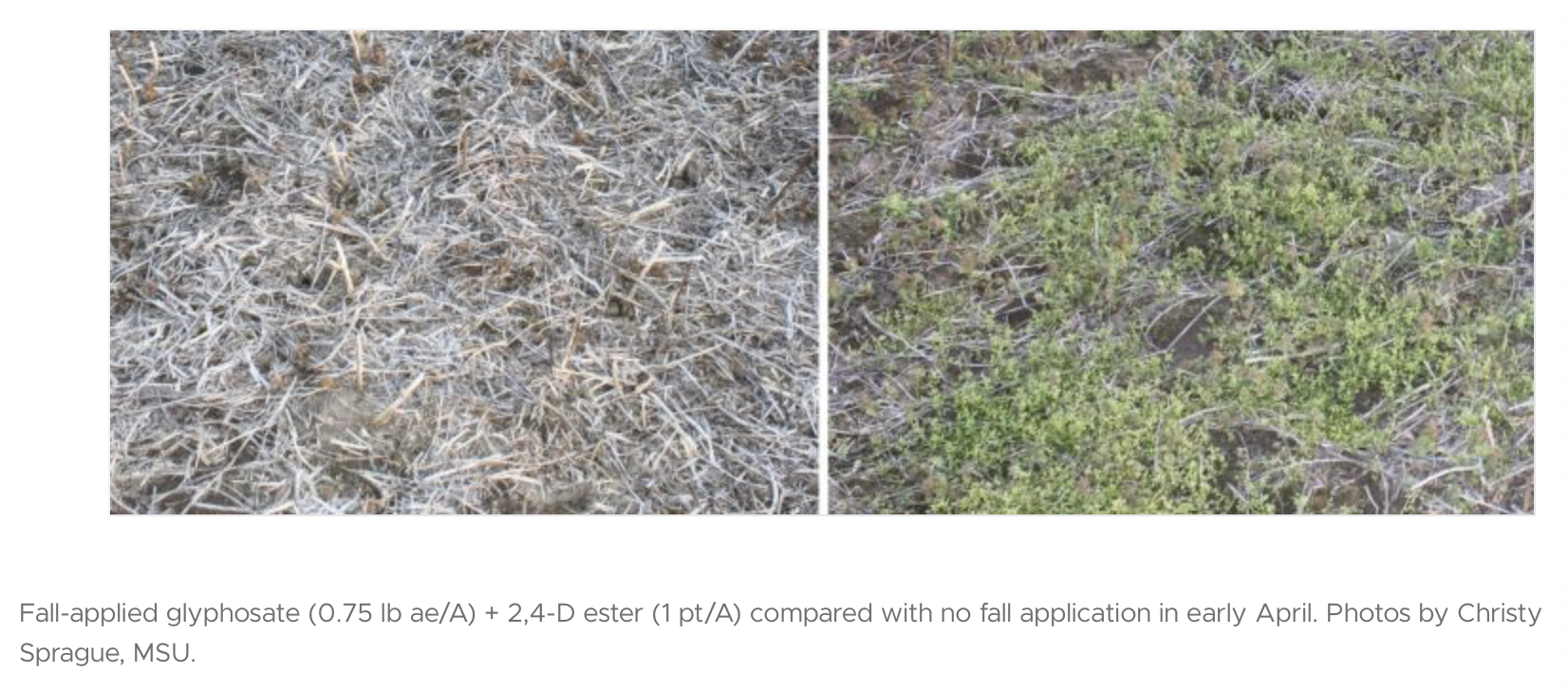Country Selector
Please enter a valid location
Fall herbicide application offers multiple benefits

No-tiller farmers understand how fall herbicide applications can reduce winter annual and perennial weeds like dandelion, henbit, chickweed and purple deadnettle that like to overwinter and create a carpet before spring.
However, what farmers battling herbicide-resistant horseweed (marestail) may overlook is the ability to reduce its impact starting in the fall.
Crop economics certainly must be considered, as fall applications are not a replacement for spring control of marestail. But they may be a smart investment to try it on your worst herbicide-resistant marestail field. Fall control leads to better control in the spring due to fewer differences in weed size.
Christy Sprague, weed scientist at Michigan State University, stresses that marestail “is a tough weed because it emerges throughout the season. But we can reduce populations in the fall.”
A growing problem
Herbicide-resistant marestail is highly problematic across the Midwest. University and North Central Weed Science Society surveys report heavy glyphosate resistance in Illinois, Indiana and Ohio — in 50% to 70% or more of fields. It is also reported in 20% to 40% of the fields in Iowa, Minnesota, Wisconsin and Michigan. No Corn Belt state is entirely free from herbicide-resistant marestail.
Sprague said fall herbicide applications won’t negate spring herbicide applications. But fall control can improve spring marestail size consistency. To help clean up severe marestail fields, growers can take a more strategic approach with a fall application and a spring burndown residual spray.
“Without fall application, farmers see a wide variety of marestail plant sizes come spring, making burndown less effective on larger plants,” Sprague says. “Fall control also reduces the marestail population, and that helps spring control a lot.”
In her fall application research trials on marestail, Sprague achieved good control by using saflufenacil (Group 14) as the base herbicide.
“Generally, we include glyphosate, methylated seed oil and ammonium sulfate. We’ve had extremely good results with this mix on fall marestail control,” she said.
Sprague considers every marestail plant to be resistant to glyphosate and ALS inhibitors, encouraging growers to rotate chemistry combinations to control resistant populations.
Depending on the weed species in the field, growers also use 2,4-D or dicamba to control emerged weeds. Atrazine can be a good option for growers planting corn in the spring. Check herbicide labels for fall recommendations, including rates, combinations, adjuvants and temperature ranges for applications.
Sprague said fall also offers the opportunity to use higher rates of glyphosate, 2,4-D and dicamba to help move herbicides into the root system to control dandelions.
When to apply
Delaying fall application gives winter annuals, perennials and marestail time to emerge through crop residue to optimize control with nonresidual herbicides.
“We like to fall-apply around 50 degrees, but an air temperature range between 40 and 60 degrees seems to work well whether controlling winter annuals or perennials,” she said. “So, when it starts to get really cold in December, you won’t get any benefit. But we’ve seen good results even into November in Michigan.”
One rule of thumb is to apply one to two weeks before the first expected frost. Farther south, the application temperature window extends to Thanksgiving and sometimes beyond. Dandelion control can improve after a frost because it triggers the plant to move the chemicals into the roots.

Tillage or cover crops?
The most effective strategy is integrated weed management that incorporates multiple herbicide modes of action and the use of cover crops, crop rotation and tillage.
Sprague and other university weed scientists report suppressed emergence of winter annual weeds and marestail when seeding a cereal rye cover crop in the fall.
“We’ve seen good early season marestail control due to cereal rye cover crop growth in the spring,” she said. “Growers who are successful at planting green into the cover crop, then killing it after planting, are seeing longer season control benefits thanks to the rye residue on the soil surface, especially in soybeans.”
Growers still practicing fall tillage (which is harmful to soil health and can cause erosion issues) likely won’t have many fall weed issues unless it’s done early, giving weeds time to grow.
Shallow or minimum tillage may scatter seeds across the soil surface, increasing germination and leading to higher marestail populations in the spring.
For a deeper dive
The following are additional resources on the benefits of fall herbicide application:
- "Getting a start on weed control in the fall” (Michigan State University); https://www.canr.msu.edu/news/getting-a-start-on-weed-control-in-the-fall
- “Considering Fall Herbicide Options in Corn and Soybeans” (University of Missouri); https://ipm.missouri.edu/croppest/2008/10/Considering-Fall-Herbicide-Options-in-Corn-and-Soybean/index.cfm
- “Fall-Applied Herbicides: Which Weed Species Should be the Target?” (University of Illinois); https://farmdocdaily.illinois.edu/2018/08/fall-applied-herbicides-which-weed-species-should-be-the-target.html
- Search for herbicide resistance to marestail (Conyza canadensis) or any weed — https://www.weedscience.org/Pages/Species.aspx
Atrazine is a Restricted Use Pesticide.
Content provided by DTN/Progressive Farmer
The More You Grow
Find expert insights on agronomics, crop protection, farm operations and more.
